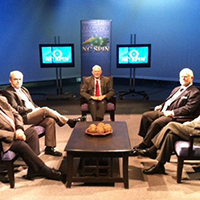School Daze
Published May 28, 2020
By Tom Campbell
Public schools are supposed to begin the new year about 75 days from now, so I asked two teachers what to expect. “I have no idea,” one said. “I’m exhausted just trying to get this year finished. It’s been especially hard this year.” The other added, “So far as next year, if there’s a plan we don’t know it. I can’t even get back into my classroom.”
Time is becoming essential to learn how North Carolina’s children will return to school August 17th. I can just picture up to forty children riding to and from school in a bus, piling into classrooms never designed for social distancing, spilling into hallways and playgrounds, then eating lunch en masse in cafeterias. It is not a vision that looks safe.
For decades we’ve been talking about the need to reform public education and, while doing so in the middle of a pandemic may not be ideal, it certainly provides the motivation needed. We need some strategic and innovative thinking.
Let’s start by acknowledging that we must get our 1.5 million k-12 students back in school. Online learning, which holds promise, has yielded mixed results. Some students did well, but many didn’t; they didn’t have tablets, available high-speed broadband Internet or proper instruction. Our education system wasn’t adequately prepared and far too many students essentially lost the last third of the school year. We can learn from what worked, what didn’t and do better next time. When students return to class their teachers will need to assess how much remediation is needed.
Priority one is the need to sanitize schools every day. We need a nurse or certified nursing assistant in each school so that, at the minimum, each student’s temperature will be checked every morning upon entering. Ideally, periodic testing will be administered to identify those infected. It is universally accepted that frequent handwashing and student distancing are essential. Since most classrooms will not allow the desired six feet of separation, the numbers in each classroom will likely need reducing.
The value of in-person instruction, especially in early grades, cannot be overestimated. Some systems have experimented by staggering dayparts. Some students come early, are dismissed, rooms are sanitized, and another cohort takes the late shift. Other programs alternate the number of instruction days, with some students present Monday-Wednesday and Friday and others on Tuesday-Thursday and Saturday. Online instruction, assignments and tests are offered on those days when children are not present in class. North Carolina already has a teacher shortage and any of these options will require more teachers, along with transportation and other challenges, but the biggest might be how working parents can accommodate children’s schedules.
Our spin is that school systems need more flexibility. We can demand certain prerequisites, like course offerings, course requirements and other essentials, but we already allow charter schools more flexibility, so let’s give all schools fewer controls, then hold them accountable. Systems in counties with very few cases of coronavirus might decide to go back to traditional school days and calendars, while those counties with many cases might determine different solutions.
But whatever the options chosen it is important that parents, employers and communities know those decisions. And they need to know very soon.







